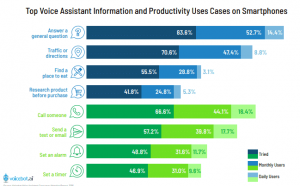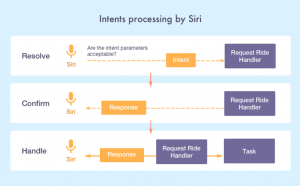
By admin / June 16, 2020
HOW TO MAKE A VIRTUAL ASSISTANT LIKE SIRI AND GOOGLE ASSISTANT
Could you have imagined 10 years ago that you would be able to talk to a phone and it would perform tasks by itself with only voice commands and no actions on your part? Supposedly not. Maybe it would have sounded crazy at that time, but now it’s real and available for everyone – Artificial Intelligence has no limits if talking about solution integration in the tech world.
Voice assistants are not fantasies of our imaginations any longer. While people are busy with their lives, and usually lack time for searching and basic phone and life management, virtual assistants save people time and accomplish these tasks for them. Moreover, virtual assistants are not just smart software for users, but a friend whom they can ask for help.
Siri, Aleksa, Cortana, and Google Assistant have become some of the peoples’ best friends today and the fact that they are not real people doesn’t make them less important to us. Life gets easier with voice assistants, as they are here for us any time we wish to use them. All we have to do is to say ‘Hey, …” and they will immediately do what we want or search for what we need.

Voice Assistants: What Are They and Why Are They So Popular?
Voice assistants are software agents that can perform tasks based on audio commands, which makes them irreplaceable in life today.
Voice assistants can help a person with the following tasks:
- To call, send a message, open and read messages sent to you
- Find news, weather forecasts, currency, definitions
- Create reminders, notes
- Add events to a calendar, schedule meetings
- Perform general screen actions (i.e., set an alarm, increase the brightness of a screen, turn on/off Wi-Fi connection, play music)
- Navigation searches: to show the road from point A to point B
- Entertainment: interesting events in the city, what film to watch, where to go on the weekends
Let’s discover together what brings voice assistants such popularity among users, and why they’re the right tool for your business development:
- Simple to find and use: screen usage is no longer required to do something on your phone. Your voice is the key instrument.
- Fast: in the traditional format, you have to unlock your phone, find Google, type what you want to find, wait for search, read several titles to choose what link is the most suitable for you, and then search for a specific part of a text. With a virtual assistant, it takes requires only the time for you to say what you want and immediately get a result
- Effective: users are more likely to find the right answer to a request with the help of a voice assistant rather than by themselves. The system built inside a voice assistant allows to define the most suitable answer and provide this to users while being checked and confirmed.
One more important reason to mention here is that voice assistants can help people fulfill their need to feel important. Voice assistants can serve as personal secretaries, so people can imagine themselves as business people who are always busy and have much to do. Furthermore, searching for how to cook a grilled chicken, for example, makes them feel that they are doing something more important than just making dinner.
The Guide on How to Build Your Own AI Assistant
Nowadays, the inclusion of virtual assistants in an app’s functions is a good advantage for an app, but in a couple of years, it will become an essential demand to keep an app competitive on the market and worth the users’ attention. This is why you should start planning your mobile app development immediately with an included virtual assistant.
We have prepared a step by step guide in order to help you create an AI voice assistant:
Step 1 Plan your voice assistant app strategy
Your voice assistant app should be created with a specific goal while focusing on your target audience. Some voice assistants are working mostly with work tasks like Cortana, and others with daily routine activities like Google Assistant. Your task at this stage of voice assistant app development is to define what will be the unique service you will offer to your users, and based on this, we will talk about what features to include.
You can go through the most time-consuming tasks people are performing every single day and discover how your voice assistant can automate these tasks.

Keep in mind that the purpose of creating an AI voice assistant should lie not only in helping your business but in helping your users who will later use your app if it’s helpful to them. That’s why it’s important to include the users’ preferences in app development. The kind of tasks a voice assistant can help with, the tone of voice, manner of speaking, duration of pauses – all of these matters.
The idea here is not to become another feature-packed technology but to achieve a user-friendly experience so users can feel like talking to their friends via phone, not just to phone. What makes people return to an app is a personality they like and are comfortable with 24/7.
Step 2 Integrate a voice assistant to your app with custom APIs and AI tools.
Adding and integrating an existing voice assistant like Siri and Google is now recommended by MindMeld research, as they are among the leaders according to user opinion. So let’s take a look at these 2.
Siri
Since 2016 it is possible for third-party apps to incorporate Siri, as it launched a special tool – Apple SiriSDK which provides 2 types of extensions for Siri integration: Intents which is responsible for doing tasks such as calling and messaging, and Intents UI which visually controls brand and custom content on the user’s interface.
These Intents extensions are possible tasks a user can request. The system processes them as classes with certain properties. For example, a user wants to know the weather forecast for the next week in a specific city. Having received a voice task to perform, the system defines the properties for it – here we have properties such as specific dates and the indicated location – which then transfers them to the app extension that gives us an appropriate result.

However, Apple has some restrictions for design, so it can be a problem for developers if creative solutions need to be added.
Google works almost the same as Siri but it is much easier as it doesn’t concern developers with design limitations or set boundaries regarding their imagination. Basically, it offers 2 ways of how to make your own AI assistant within it – Google Now and Voice Actions.
Google Now is a highly technological voice assistant that can understand, process, analyze and complete requests from users. However, only selected apps such as eBay and Airbnb can be granted with the possibility to use Google Now and create their own Now Cards while using special APIs.
In any case, you still can register and use Voice Actions API to create the possibility to use voice commands both on phones and computers for your users. This is simpler than Google Now but can only perform requests through voice recognition. However, there is a specific requirement in order to use Voice Actions – you have to register an app on Play Market and have it approved. In fact, the approval process in Google is shorter than in Siri’s case. Follow the guide on how to start using this platform.
Step 3 Add essential features
Here is a list of requirements needed for the creation of an AI voice assistant from scratch:
Voice/speech to text (STT)
Voice assistants as software agents can process only digital messages. So, they convert voice tasks given by users into the text to be able to analyze them and perform. This process can be implemented by a software called CMU Phoenix.
TTS process
The TTS process works the same as the STT process but in the opposite way. With TTS, text data, such as information on weather, can be translated and provided in human speech. CMU Phoenix program is a tool to be used.
Decision Making
This process defines your voice assistant app’s effectiveness at this stage, the AI technology analyzes a user’s request, interprets it and gives the answer. The response is made through tagging elements that can be relevant for the user. For example, if a user wants to find a film to watch in a cinema, a voice assistant gathers all possible options that may be interesting for the user based on his/her previous requests. The smarter a voice assistant is, the more it is aware of the user’s preferences, so the more relevant answer it can provide.
Noise elimination
People use their phones on the streets, in a cafe, in general, in crowded and noisy places. This feature defines how clearly your AI assistant will hear a user despite all the noise in the background. Noise control minimizes or absolutely eliminates sounds that are not related to the user’s voice or the request itself.
Voice recognition
If you don’t add voice recognition technology to your voice assistant, your users will likely be misunderstood by assistants and given the wrong answer as a result. This also helps you to prevent such comic situations where a voice assistant responds to voices from TV shows, animal sounds, etc.
Compress the speech
This feature is responsible for the fast delivery of an answer to the user. The server on which the communication with the user is recorded should be reliable and safe. It’s recommended to use the G.711 standard to avoid losing data.
UI/UX experience
Voice interface is what a user receives in response to a request: a screen, voice, manner of speaking, etc. All of this creates the user’s experience as the user doesn’t want just to have an answer, but also, high-level service. So, think about the visual and audio representation a user will receive as feedback from your app.
You can find plenty of platforms to build your own AI assistant on, but you have to be sure that this group of people can provide a set of features you’re planning to include in your app. Contact us to, not only build a voice assistant but to ensure its efficiency for your business.
Conclusion
Voice assistants tend to be a good addition to mobile app development, which leaves us with no doubt that voice assistants must be considered while building a mobile app.
Your task as a business owner is to take care of your target audiences’ needs and help them in organizing their lives. This will make your app the first thing users turn to for information and help. Let’s leave simple tasks to voice assistants – they already know what the answer is, just ask them.